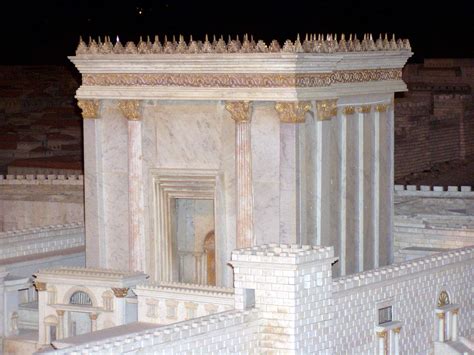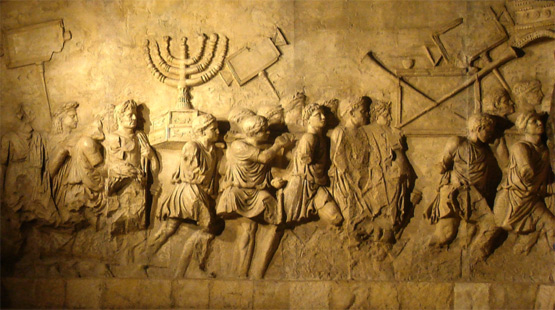The Seventy Weeks of Daniel -- An Interpretation of Daniel 9:24-27 (Part One)
 Tuesday, July 7, 2020 at 04:06PM
Tuesday, July 7, 2020 at 04:06PM I. Jesus, the Temple, and the Prophecy of Daniel (The Background to Daniel's Prophecy of the Seventy Weeks) My exposition of the famous "Seventy-Weeks" prophecy of Daniel (Daniel 9:24-27) begins in what is perhaps a surprising place–the Gospel of Matthew with Jesus giving his so-called "Olivet Discourse." The discourse is so named because Jesus and this disciples were sitting on the Mount of Olives, looking across the Kidron Valley at the magnificent Jerusalem temple, restored to its original grandeur by King Herod. Jesus uses this occasion to predict the destruction of the temple and the city of Jerusalem, as well as discuss the end of the age. When passing the temple earlier that day, his disciples asked him a question about the end of the age and what would happen to this great building. Jesus told them, “you see all these, do you not? Truly, I say to you, there will not be left here one stone upon another that will not be thrown down” (Matthew 24:2). The magnificent second temple will be completely destroyed–again.
My exposition of the famous "Seventy-Weeks" prophecy of Daniel (Daniel 9:24-27) begins in what is perhaps a surprising place–the Gospel of Matthew with Jesus giving his so-called "Olivet Discourse." The discourse is so named because Jesus and this disciples were sitting on the Mount of Olives, looking across the Kidron Valley at the magnificent Jerusalem temple, restored to its original grandeur by King Herod. Jesus uses this occasion to predict the destruction of the temple and the city of Jerusalem, as well as discuss the end of the age. When passing the temple earlier that day, his disciples asked him a question about the end of the age and what would happen to this great building. Jesus told them, “you see all these, do you not? Truly, I say to you, there will not be left here one stone upon another that will not be thrown down” (Matthew 24:2). The magnificent second temple will be completely destroyed–again.
Jesus is predicting something unthinkable to a Jew of that day, since the Jewish people had endured this terrible fate once already. This time, Jesus implies, the destruction of the temple will be final. While predicting the destruction of the temple and teaching his disciples about the end of age, Jesus repeatedly appeals to the prophet Daniel. So it is here we begin our exposition of the "Seventy Weeks" prophecy of Daniel–with Jesus, on the Mount of Olives, teaching his disciples about the time of the end, all the while quoting from or alluding to Daniel’s prophecies. By considering how Jesus understood the Book of Daniel, and then spoke of his own role in fulfilling key portions of Daniel’s prophecies, we gain the proper perspective to interpret Daniel’s "Seventy Weeks" prophecy correctly.
Taking this brief if surprising detour to provide the necessary background to interpret Daniel’s widely disputed prophecy is important, because this is a difficult prophecy to interpret, especially without the proper redemptive-historical context.
Before we take up the Olivet Discourse (part two) and then turn to the Seventy Weeks prophecy (parts three and four), we begin with a bit of historical recap regarding the exile, the return from Babylon, and the rebuilding of the temple. The first Jerusalem temple (built by David and Solomon) was destroyed by the Babylonian king Nebuchadnezzar in 587 BC in the days immediately before the Babylonian exile. Daniel served in Nebuchadnezzar’s royal court and even interpreted one of the king’s dreams (Daniel 2:51 ff.). The destruction of the temple and the sacking of Jerusalem in 587 was Israel’s darkest moment, yet Jesus predicts an even darker day yet to come for Israel–a day of terrible distress foretold by Daniel (Daniel 9:26-27).
In the days of Ezra-Nehemiah–who write a century or so after Daniel–we read of how the Jews eventually returned to the land, and rebuilt their temple in 516 B.C. After four centuries of struggle and oppression by Gentile empires, by the time of Jesus, Israel’s national identity once again centered around this magnificent building. But the Jews chaffed under Roman rule. Although back in their land with a rebuilt temple, Herod's "kingdom" was nothing but a back-water vassal state in a Roman dominated world. Although a Jew, Herod was a Roman lackey. The political tensions between Herod and the Jewish people were already high when Jesus began his messianic mission.
The Jerusalem temple figures quite prominently in the last week of Jesus’ earthly ministry, because the increasingly heated conflict between Jesus and the scribes and Pharisees had escalated to the point of no return once Jesus entered the temple after his triumphal entrance into Jerusalem on Palm Sunday, only to find his messianic mission challenged and then rejected by Israel’s leaders. Though the temple pointed to the work of redemption that Jesus was about to accomplish with his death and resurrection, the Pharisees sought to keep Jesus from preaching in his Father’s house.
The tragic irony in all of this is that Israel’s spiritual condition had fallen to the same level of unbelief as in the days before the Babylonian exile. The temple had become an idol because of its grandeur. The people’s hearts are once again far from YHWH. The religious leaders trust in their rituals and in human righteousness. They think the temple, the law, religious ceremonies and festivals, and circumcision are ends in themselves. They see no need for the righteousness of Jesus Christ, thinking their own quite sufficient (cf. Romans 10:3-4). Yet, Daniel foretells of a time when an "anointed one" will come, who will usher in the very righteousness of God, to be freely given to his people, and to be received by faith alone (Daniel 9:24).
John the Baptist had come several years before Jesus began his own messianic mission, with John preaching a baptism of repentance and warning Israel that her time was nearly up. Only Herod put John to death. And now Jesus, the covenant mediator has come to dispense the covenant curses and blessings upon this nation which has rejected his messianic mission and office. In Matthew 23, Jesus pronounces covenant curses upon the Pharisees and teachers of the law, prophesying that the nation of Israel will be left desolate. Echoing the prophets, Jesus also spoke of a time of Israel's future restoration. If this was not troubling enough, Jesus also informs the disciples that the magnificent temple of Herod will be completely destroyed. They are perplexed and troubled by what they hear. They too know the prophecy of Daniel.
In addition to Jesus' warning that the covenant curses are near, and that Israel will be left desolate, it was the news about the temple which prompted the disciples to ask Jesus a series of questions about the future course of history as it relates to Israel and the temple, which Jesus answers in the Olivet Discourse. When the Discourse begins in verse 3, “as he sat on the Mount of Olives, the disciples came to him privately, saying, `Tell us, when will these things be?’” As far as the disciples were concerned, the very thought of such a calamity as the destruction of the temple must also mean that the end of the age is at hand. The disciples also ask Jesus, “what will be the sign of your coming and of the end of the age?” As they see it, the destruction of the temple and the end of the age must be one and the same event.
As the Olivet Discourse unfolds, Jesus addresses a number of important matters (especially the fate of the Jewish people, their temple, and Jerusalem), all of which are features of Daniel’s prophecy. So, I think it helpful to begin here because Daniel’s prophecy is no doubt in Jesus’ mind when giving the Olivet Discourse (Matthew 24, with its parallels in Mark 13 and Luke 21). Throughout the discourse, Jesus quotes or alludes to many prophecies found in Daniel, especially as these prophecies which impact the future role of the temple and the city of Jerusalem in redemptive history. In the Discourse, for example, Jesus refers to himself as the mysterious divine figure (the Son of Man), who is the central figure in one of Daniel’s previous visions (chapter 7). He warns of an "abomination of desolation" spoken of by Daniel (Matthew 24:15). This is why we must understand Daniel as does Jesus.
Unfortunately, the interpretation of the Olivet Discourse is highly disputed and one’s position on the meaning of Jesus' words often colors how one reads and understands the prophecies of Daniel. One such approach to the Olivet Discourse is called preterism. This view understands Jesus to be describing the judgment to come upon Israel when the Roman army destroyed the temple and sacked Jerusalem in A.D. 70. Accordingly, everything in Matthew 24, including the coming of Christ upon the clouds in glory, was fulfilled by the events of A.D. 70. However, orthodox (or "partial") preterists, do believe that the culmination of biblical prophecy is the bodily return of Jesus on the last day.
A much more popular approach, called futurism, sees much of Jesus’ explanation as referring to a time in the distant future in which Israel is back in the land with a rebuilt temple. This view, which is associated with dispensationalism and very popular among American evangelicals, understands the Olivet Discourse to be referring to a future tribulation period in which Antichrist makes a peace treaty with Israel, but then turns upon the Jews and desecrates their temple.
Both these views, futurism and preterism, mistakenly assume that the disciples are correct when in their questions to Jesus they link the destruction of the temple to the end of the age. The difference between them is that preterists locate this in the past (A.D. 70), while the futurists place this after the so-called "rapture," when Christians are mysteriously “snatched away,” when the Antichrist appears.
The best way to understand the Discourse is to notice that the disciples have made an incorrect, albeit understandable assumption when they question Jesus–that the destruction of the temple and the city of Jerusalem is the end of the age and must be somehow associated with the coming of Christ in the clouds with great glory. But Jesus will correct this mistaken assumption and speak of two distinct events separated by an indeterminate period of time (this is characteristic of so-called Reformed amillennialism). The first event to occur is the destruction of the city and the temple, and includes the horrible suffering of A.D. 70, after which Israel will be cut off and left desolate. The second event of which Jesus speaks is the end of the age, when the Son of Man returns in final judgment at the end of the age.
The key, then, to interpret the passage correctly, is to look at the disciple’s questions and to see how Jesus answers them (in light of Daniel’s prophecy) so as to correct their misconception about the destruction of the temple and the end of the age being the same event. As we will see from Jesus' answers, these two complexes of events (Jesus' death, resurrection, and ascension, followed by the destruction of Jerusalem and the temple in A.D. 70, and then his second coming at the end of the age) are the redemptive-historical bookends of the interadvental age.
End of Part One


Reader Comments